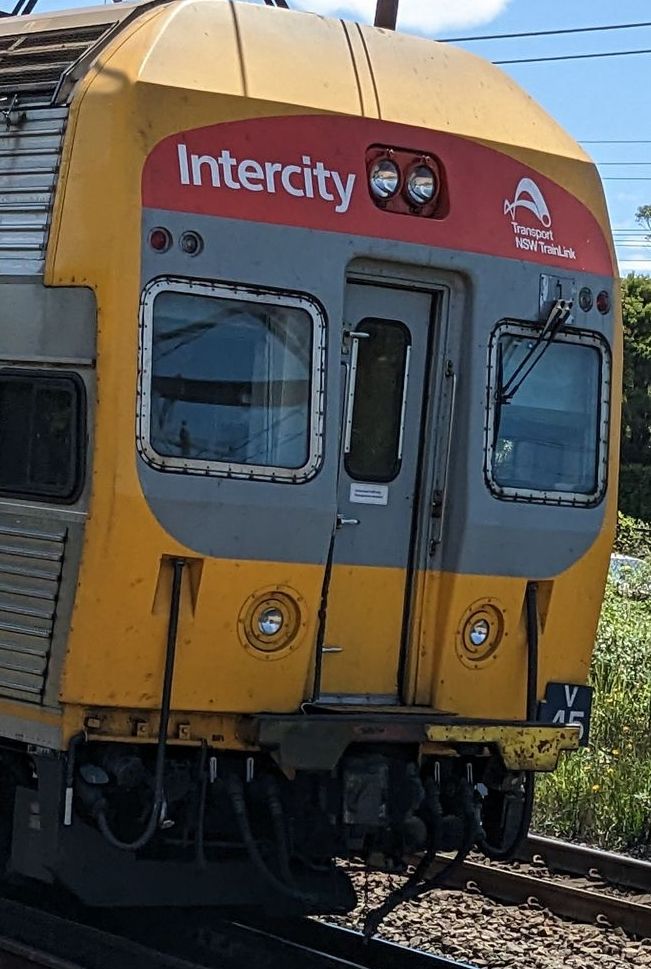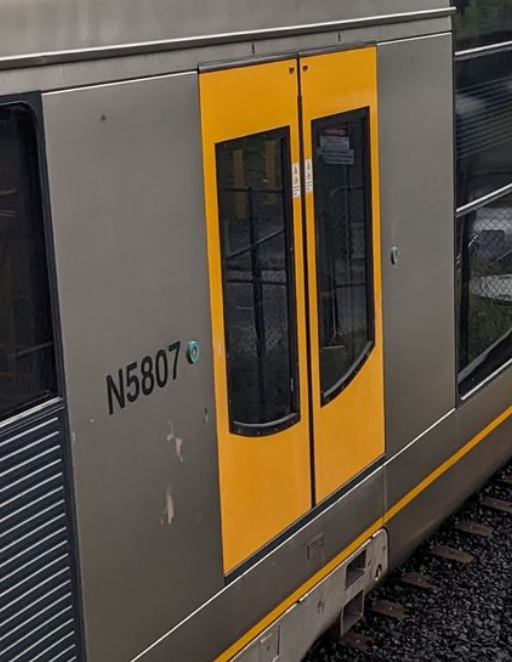Trainspotting Tricks (Sydney Trains)
Update on 2024-03-24: Corrected mistakes in OSCAR and Millenium numbering.
This page details trainspotting tricks for the Sydney Trains Suburban and Intercity Fleet. For details on the trains themselves, see Sydney and Intercity train fleet.
Target Plates #
To identify a particular set, the simplest way is to read the Target Plate located in the bottom right at the front and rear of a train set.[1] On newer A/B sets (Waratahs)[2] the target plate is simply a sticker, but the details contained on the plate are the same.

The letter indicates the set type. Types still in operation by rough age are:
- (2GT) V set (sometimes referred to as intercities, e.g. on TripView)
- (2GT) K set
- (3GT) T set (Tangaras)
- (4GT) M set (Milleniums)
- (4GT) H set (OSCAR)
- (4GT) A set (Waratah series 1)
- (4GT) B set (Waratah series 2)
- (4GT) D set (Mariyung/NIF)
The following number indicates the set number. Note that while the set number is roughly in order of age (within the set type), there are many exceptions, especially with (but not exclusively) 2nd or 3rd gen (2GT/3GT) sets.
The colour of the target plate has meaning as well, but it is not always true anymore.
- Mortdale: Red
- Flemington: Blue
- Hornsby: Black
- Auburn: Green (only M sets)
Green is confusing, it is used for H sets based in Mortdale and Hornsby, as well as for M sets based in Auburn.
Carriage Numbers #
If you don't manage to catch a glimpse of the target plate, one way to identify a set is from the carriage number. The carriage number is a letter (sometimes two or three), following by four numbers. For instance, N5807 is the carriage number for a car of set T126.

V, K, and T sets #
There is no useful pattern here. Give up and look at the List of Sydney Trains/NSW TrainLink fleets.
Sets T100-T130 are the ex-intercity G sets.
M sets (Milleniums) #
These sets consist of 4 cars semi-permanently coupled. They are usually run as 8-car sets (2x4 cars), coupled with an automatic Scharfenberg coupler. The sets are made up of the following:
- Control trailer carriage: D10XX
- Non-control motor carriage: N15XX
The sets are formed as D10YY--N15YY--N15XX--D10XX, where
To determine the set number from the carriage number, if the last two digits
-
01 and 40, then the set number is
(ceiling). So set number is between 01 and 20. -
43 and 60, then the set number is
. So set number is between 21 and 29. -
62 and 73, then the set number is
(floor). So set number is between 30 to 35.
Exceptions:
- D1041 replaces D1027 of M14. Additionally, D1042, N1541, and N1542 do not seem to exist.
- D1061 and N1561 also do not seem to exist.
H sets (OSCARs) #
These sets consist of 4 cars semi-permanently coupled. They are often run as 8-car sets (2x4 cars), coupled with an automatic Scharfenberg coupler.
For sets H1-H49, carriage numbers follow the below format:
- Control trailer carriage: OD69XX
- Motor carriage: ON59YY
- Motor carriage (with toilet): ONL59ZZ
For sets H50-H55, carriage numbers follow the below format:
- Control trailer carriage: OD68XX
- Motor carriage: ON58YY
- Motor carriage (with toilet): ONL58ZZ
To determine the set number, if your carriage number is of the form
-
ON59XX, then the set number is
. So set number goes from 01 to 49. -
ONL59XX, then the set number is
. This is 50 less than non-toilet. So set number goes from 01 to 49. -
ON58XX, then the set number is
. So set number goes from 50 to 55. -
ONL58XX, then the set number is
. This is 50 less than non-toilet. So set number goes from 50 to 55.
Another way to think about this is that the ones with 8 as the 2nd digit, you must add 29 (50 - 21) to the calculations used for the ones with 9 as the 2nd digit.
Else, if your carriage number is of the form OD69XX, with
- 01 and 20, then the set number is
(ceiling). So the set number goes from 01 to 10. - 23 and 98, then the set number is
. So the set number goes from 11 to 48.
If it is of the form OD68XX, then
Exceptions:
OD6921andOD6922actually belong to H49, instead of H11. This makes your life hard.OD6999does not seem to exist.
A and B sets (Waratahs) #
These sets consist of 8 cars, semi-permanently coupled. Carriage numbers follow the below format, where YY is the set number.
- Trailer driving carriage: DXXYY
- Non-driving/motor carriage: NXXYY
- Trailer carriage: TXXYY
Sets A2 and A79 do not exist, car D6379 is the leading driving car of set A42 due to a crash at Richmond in 2018 (RO-2018-004).
The train formations are as follows:
- A sets:
D63YY--N53YY--N55YY--T65YY--T66YY--N56YY--N54YY--D64YY - B sets:
D11YY--N17YY--N19YY--T13YY--T14YY--N18YY--N16YY--D12YY
D sets (Mariyung) #
It is believed that the last two digits of the carriage number correspond to the set number.